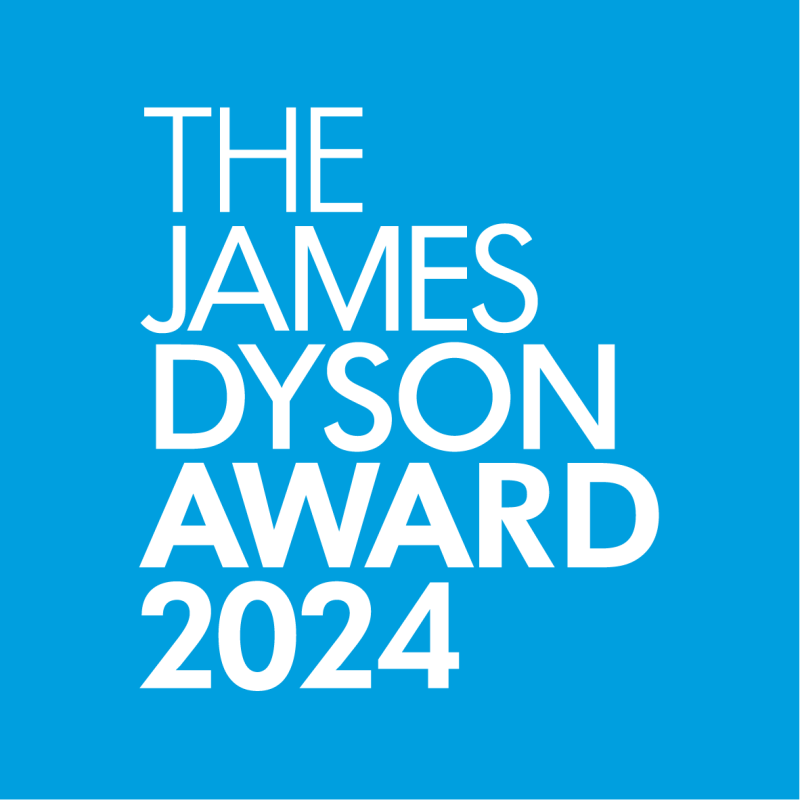James Dyson Award maakt de wereldwijde winnaars van 2024 bekend
Vandaag maakt de James Dyson Award zijn twee wereldwijde winnaars bekend, die elk £30.000 ontvangen voor het oplossen van belangrijke mondiale problemen op het gebied van geneeskunde en duurzaamheid:
James Dyson Award announces its 2024 global winners: Hair-loss prevention device for chemotherapy patients and Sustainable ‘maple seed’ weather balloon
Today [13.11.24], the James Dyson Award unveils its two global winners, each receiving £30,000 for solving significant problems of global importance in medicine and sustainability:
- Athena is the global Medical Winner. Invented by 24-year-old designer Olivia Humphreys (Ireland) after she witnessed her mother’s painful battle with cancer, Athena is an affordable – and portable – device for chemotherapy patients that uses scalp cooling to prevent hair-loss. It is 1⁄20 of the price of existing technology, and can be used outside hospital, reducing the time patients are forced to spend on wards.
- airXeed Radiosonde is the global Sustainability Winner. Invented by postdoctoral researchers Shane Kyi Hla Win and Danial Sufiyan Bin Shaiful (Singapore), airXeed is a reusable, nature-inspired sensor for weather forecasting. Unlike current weather balloons, it does not create tonnes of plastic and electronics waste, and intelligently descends like a maple seed to avoid aircraft collisions and land in designated collection zones.
The international student design competition, which has now supported more than 400 problem-solving inventions from young engineers and scientists worldwide, received nearly 2,000 entries this year.
Speaking of the 2024 winners, James Dyson said: “We started the James Dyson Award nearly 20 years ago to encourage students at university to solve problems. And we’ve had thousands and thousands of entries since. It’s wonderfully encouraging to see how many students have solutions to severe global problems. Instead of sitting back and talking about it, they’re doing something about it – and that’s what the James Dyson Award encourages. We’ve got two brilliant winners this year which we’re thrilled to support, and I hope the Award will give them a springboard to future success.”
James Dyson surprised Olivia, Shane and Danial with the exciting news during an online video call. Watch how it went down on YouTube.
Medical Winner – Athena, by Olivia Humphreys from Ireland.
The problem
Some 65-99% of patients going through chemotherapy will be affected by chemo-induced hair loss[1]. Current hair-loss prevention techniques commonly use scalp cooling, a method which involves applying ice cold temperatures to the scalp before, during, and after chemotherapy, which can be very painful for patients. It mitigates hair loss by shrinking blood vessels and limiting blood flow to the scalp. After chemotherapy, cooling can also help hair grow back faster and stronger[2].
However, the availability of scalp cooling is limited due to its high costs. This year’s Medical Winner is from Ireland where the Minister for Health estimated the total cost of installing a scalp cooling machine at €216,000[3], with additional costs needed for staffing as the treatment requires additional help to operate the equipment.
Ensuring the equipment fits the patient properly and the extended time it means someone needs to be in hospital for are additional hurdles. There are cheaper, manual cooling alternatives available, yet these are less powerful, and they don’t provide long-lasting effects.
Not all hospitals offer scalp cooling for patients too. In fact, in Ireland, scalp cooling is only available in eight out of the country’s 86 hospitals[4]. [Please find this statistic for your market and only include if compelling.]
[1] National Library of Medicine. See here.
[2] Source: Macmillan.
[3] Oireachtas. See here.
[4] Green Party. See here.
The solution
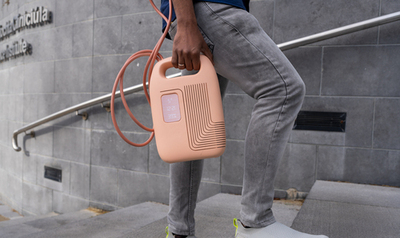
Olivia Humphreys, a 24-year-old product design and technology graduate, invented Athena to tackle these issues after witnessing the impact of chemotherapy-induced hair loss when her mother was diagnosed with cancer in 2019. Having spent time with her mother during treatment, Olivia was inspired to reimagine hair-loss prevention technology.
Athena is a portable, thermoelectric hair-loss prevention device that uses scalp cooling. It’s more cost effective and timesaving than current hospital models, without compromising on the quality of treatment.
Current scalp cooling products use refrigeration technology requiring constant plugged in power. The patient must arrive at hospital 30 minutes early and stay for 90 minutes after infusion for pre and post scalp cooling. Battery powered Athena, weighing around 3kg, consists of a carry case and a cooling headpiece, that fits to different head shapes, and enables people to spend less time in hospital on a chemotherapy infusion day. It works by using low-cost thermoelectric semiconductors called Peltiers, and these cool a tank of water, which circulates the cold water around the head with the smartly designed headpiece.
With Athena, patients can start and end the scalp-cooling process themselves from wherever they wish, such as the comfort of their own home. At full power, it can run for 3.5 hours, allowing the patient to commute to and from the hospital while cooling, and move around during infusion, such as for bathroom visits. Athena aims to give control back to patients during a time when they usually have little of it. Athena is patient-centric and so Olivia also chose bright colours for the device’s materials as a change from conventional, clinical colours found in hospitals. Taking its name from the powerful Greek Goddess of wisdom and battle strategy, for Humphreys, Athena is a symbol of resilience, which is a quality often seen in those living with an illness as serious as cancer and going through the necessary treatments.
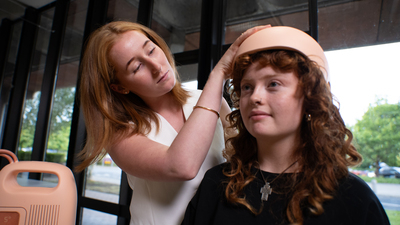
The estimated cost for Athena would be around €1,000, according to Olivia, which is significantly less than industry machines which start at around €20,000. Athena has the potential to make hair-loss prevention more accessible and affordable for both patients and healthcare providers – Olivia’s ideal scenario would involve partnering with hospitals and charities to offer Athena through a rental or loan scheme. To take Athena to the next level, extensive research and development is required, and the James Dyson Award prize money will kickstart this. Long term, Olivia is exploring novel technologies for future hair loss prevention methods beyond scalp cooling.
James Dyson, Founder of Dyson, said: “I haven't had cancer, but members of my family have had cancer and hair loss is a particularly depressing and debilitating part of chemotherapy treatment. You can freeze your scalp which you have to do in special facilities, but these aren't always available, are costly and it’s very painful. This year’s Medical Winner, Olivia Humphreys, has tackled this problem by designing Athena, for portable scalp cooling. You can wear it while you travel, you can wear it in the car to and from hospital, you can use it at home – it’s a low-cost alternative available to everybody, with the potential to make a real difference.”
Speaking about the development of Athena, Olivia Humphreys said: “I decided to build a working prototype to test the capabilities of the Peltier semiconductors. Using a Peltier computer cooling fan system, a diaphragm pump, my mum's old suitcase, and my dad's plane battery, I was able to create a strong proof of concept to gather valuable feedback to develop the concept. Following this, I focused on the product's form, creating cardboard and foam models and determining functionality aspects and touchpoints to ensure the best user experience. Ultimately, I arrived at my final model, Athena, which was crafted using SolidWorks 3D CAD modelling.”
On winning the James Dyson Award, Olivia said: “I’m incredibly proud of the hard work, ambition, and commitment that went into creating Athena. The recognition from the James Dyson Award validates not just my efforts, but also the stories and insights shared by people who’ve experienced cancer treatment. My mum inspired this journey, and it’s incredibly emotional and rewarding to have my project reach this level. The Award has motivated me to recognise my potential, and it opens up exciting opportunities for me as a young designer and innovator.”
Professor Mark Beresford, Consultant Oncologist at the Royal United Hospital Bath, said: “Hair loss is one of the most outward and distressing side effects of chemotherapy. Current scalp cooling techniques can reduce the risk or extent of hair loss, but need to be attached in the chemotherapy unit for a period of time before and after the chemotherapy infusion, committing patients to a long day in hospital. This new mobile version will allow patients more freedom, reclaiming some of their day, and also free-up valuable chemotherapy chair time for other patients to receive treatment.”
Sustainability Winner – airXeed Radiosonde, by Shane Kyi Hla Win and Danial Sufiyan Bin Shaiful from Singapore.
The problem
Every day, weather stations worldwide launch devices via weather balloons that gather critical atmospheric data for accurate weather forecasting. These small devices, called radiosondes, measure air pressure, temperature, humidity, wind speed and direction and transmit this data back to ground stations, helping meteorologists track weather patterns and forecast conditions. However, current devices are single-use and contribute to tonnes of plastic and e-waste globally.
After reaching high altitudes, the balloon carrying the device bursts, and the sensor descends rapidly, often crashing in remote and costly-to-retrieve locations[1], without collecting further atmospheric data as it falls.
There are 1,300 weather stations around the world[2], and it’s predicted they release at least two single-use radiosondes per day. So, over a year, almost one million radiosondes are released, costing $190million and estimated to cause 48 tonnes of e-waste[3].
These devices are crucial to the rapidly growing weather forecasting industry, valued at over $2.25 billion in 2023[4] and projected to reach approximately $5.23 billion by 2032[5]. This growth is driven by the rising demand for precise weather forecasting across sectors like agriculture, energy, transportation, and aviation. Extreme weather events have increased the demand for better forecasting systems too.
[1] CBC. See here.
[2] NOAA.gov. See here.
[3] AMS. See here.
[4] Grand View Research. See here.
[5] Expert Market Research. See here.
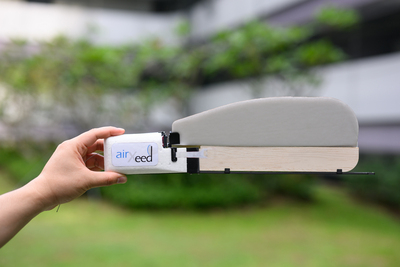
The solution
This year’s global Sustainability Winner aims to make weather forecasting more eco-friendly. AirXeed Radiosonde is a reusable device tackling the amount of e-waste created by single-use radiosondes on the market. It also aims to increase the amount of atmospheric data these devices collect, improving quality of forecasting.
Young engineers Shane Kyi Hla Win and Danial Sufiyan Bin Shaiful, from the Singapore University of Technology and Design, drew inspiration from nature to create airXeed Radiosonde. Their focus was to improve the descent and end-of-life of a radiosonde to make them reusable, reducing e-waste and minimising pollution in remote areas.
The team used the autorotation of maple seeds in their solution. A maple seed’s asymmetrical shape creates lift and drag, allowing it to spin like a helicopter as it falls. Shane and Danial applied this principle to their radiosonde design, enabling it to spiral during descent. This not only slows the device, preventing damage upon impact with the ground, but also increases the likelihood of it landing in an accessible location, making retrieval and reuse easier. The team used machine learning to optimise this design for the best flight performance. AirXeed’s controlled descent allows it to collect and transmit more atmospheric data to weather stations, as traditional radiosondes cannot do this.
To avoid collision with aircraft, and very windy conditions that could deviate the descent, Shane and Danial’s device stops autorotating when passing through aircraft cruise altitude. It enters a dive mode to increase its speed. The team have also added an onboard controller to manage the device’s stability and flight path to land without impact near the closest collection zone for reuse. This controller is enhanced by machine learning to estimate wind speed and direction onboard, as well as select the best landing location. Collection zones would be established based on weather patterns and local government collaboration. Equipped with GPS and flight navigation, the radiosonde would select the optimal collection zone from multiple options at each weather station, ensuring a smooth return based on weather and flight trajectory.
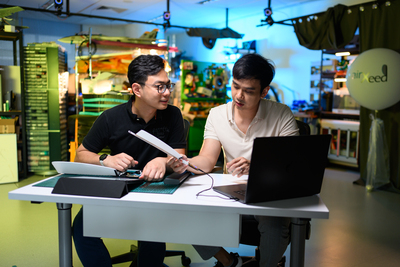
Shane and Danial prioritised sustainability in their material choice, using balsa wood and foam for the lightweight wing and cowling. Modular components allow for easy replacement and recycling of worn parts, catering to industry needs.
After winning the James Dyson Award, Shane and Danial hope to collaborate with more weather stations and weather sensor manufacturers for real-world trials to gather data and feedback to improve their invention, to ultimately bring airXeed Radiosonde to market.
James Dyson, Founder of Dyson, said: “Weather balloons that collect atmospheric information fall back to Earth and pollute the environment with electronic waste. Shane and Danial, our Sustainability Winners, have found a way of returning these devices to Earth highly intelligently to where the operators want them to land. AirXeed Radiosonde uses the maple seed principle, helicoptering down gently but also plummeting in areas where there are likely to be planes. This is a reusable weather detector, saving environmental waste and saving money. I think it’s a very clever idea.”
On winning the James Dyson Award, Shane said: “Winning the James Dyson Award global sustainability prize is a huge step forward for us. It shows that our design has potential and gives us a platform to showcase how airXeed Radiosonde can positively improve the weather industry – hearing it from James Dyson himself makes it even more special. It’s incredibly motivating to see such a prominent figure in innovation take the time to encourage young inventors like us, developing solutions that are sustainable and address critical global challenges”.
On what’s next for the team, Danial said: “With the Award’s recognition, we hope to connect with experts in the weather industry, secure partnerships and attract funding to further test and develop our design. It’s a huge boost in our journey towards turning airXeed Radiosonde into a fully realised solution that can reduce electronic waste and make weather monitoring smarter and more sustainable.”
Choo Huat Aik, Covering Director at Meteorological Service Singapore, said: “Radiosonde observations are critical in meteorology, providing detailed vertical profiles of temperature, humidity, pressure, and wind through the atmosphere. We are delighted to see young inventors like Shane and Danial taking an interest in the environmental sustainability of radiosondes with innovations that offer the potential for retrieval and reuse, and encourage them to continue innovating with a view to developing practical solutions which can support the meteorological industry."

